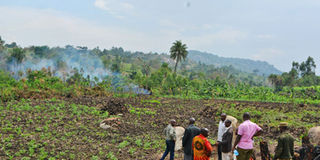Government, donors partner to restore wetlands

Inspection. Nema officials at one of the degraded wetlands in Kibale Village, Nyankwanzi Sub-county, Kyenjojo District, last year. Photo by Felix Basiime
What you need to know:
- 2013. Majority of the wetlands in Kabale District were degraded and turned into gardens and dairy farms, an official said.
KABALE. The Ministry of Water and Environment with support from the World Bank Adaptation Fund through Sahara Sahel Observatory, a non-governmental organisation, has started a five-year project aimed at restoring wetlands in Maziba, Awoja and River Aswa catchment areas.
Maziba catchment extends to Rubanda, Kabale, Rukiga and Ntungamo districts. Aswa stretches to districts of Kaabong, Kotido, Kitgum, Agago, Abim, Pader, Lira, Amuria, Otuke, Aleptong, Napak and Abim while Ajowa extends to Bukwo, Kween, Nakapiripiriti, Katakwi, Kumi, Serere, Soroti and Ngora districts.
These three water catchment areas are alleged to have lost more than 70 per cent of the wetlands due to human intervention.
While addressing the stakeholders in a meeting on Friday, Ms Annette Kezia Nantongo, a senior water officer with the Ministry of Water and Environment, said $7.75 million (about Shs29b) will be spent on the project.
Ms Nantongo, who is also the project officer, said the drive aims at increasing the resilience of the surrounding communities to the risk of floods and landslides through promoting catchment based integrated, equitable and sustainable management of water and related resources.
“All these areas that we are targeting are prone to floods. People have depleted wetlands and the effects are visible. They are at a high risk of losing all the water resources in the area as well as facing desertification if the water catchments are invaded like they are now,” Ms Nantongo said.
Coverage
Awoja catchment covers 11,000 square kilometres; Aswa catchment covers 27,631 square kilometres while Maziba catchment covers 1,370 square kilometres.
The project officials met district leaders, media and civil society organisations in Kabale to agree on the modalities of implementing the project in the region.
District leaders, however, expressed concern that the project has up-bottom approach which may limit the impact.
Kabale LC5 Patrick Besigye Kaihwa said while ministries come up with well written projects, they end up not being implemented because they lack local content.
He said locals should be involved in all the processes.
“We want a project that shall have impact, many projects the ministries bring to us are designed and executed from the centre therefore lacking local content, the reason they at times fail. We now need to get fully involved and help our people because they are the ones affected by climate change in the end,” Mr Kaihwa said.
The Ntungamo LC5 chairman, Mr Denis Singahache, who is also the chairperson of the Maziba catchment, asked the leaders in the area to embrace any project that comes to address climate change because it is negatively affecting their livelihood.
Background
2013. Majority of the wetlands in Kabale District were degraded and turned into gardens and dairy farms, an official said.
The then district wetlands coordinator, Mr Joseph Murangira, said the increasing population triggered the high demand for farming land.
He added that soil exhaustion on hill tops and the recent introduction of tea growing in the district had escalated the situation.
He said less than five wetlands out of the 72 that existed in 1980s that were in existence, adding that plans were underway to evict the encroachers.




